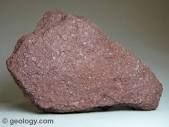
IGNEOUS ROCKS: TYPES OF DYKES
Unconformity: A buried erosional or non-depositional surface separating two rock masses or strata of different ages, indicating that that sedimentary deposition was not continuous in nature
Simple, Multiple and Composite Dykes
(ii) Volcanic Neck: In some cases, the vent of dead or dormant volcanos become sealed with intrusions - known as Volcanic Neck or Volcanic Plug
(iii) Batholith: These are the huge bodies of igneous masses that show both concordant and discordant relations with the country rock (an enormous big host rock)
These are at least 100 km long. Costa Rica Batholith of British Columbia, Canada, is more than 2,000 km long
Usually the Batholiths show granitic composition, texture and structure
Granitic: Quality or nature of Igneous Rock as being coarse-grained, light-colored and hard to very hard in hardness and chiefly composed of quartz
Granitic Structure & Texture
Formed by accumulation, compaction and consolidation of Sediments i.e. sand, silt, clay, mud which are collectively known as Soil usually in their dry condition
Sediment is defined as the particles produced from the decay or weathering of pre-existing rocks or derived from the remains of dead sea or land animals or plants in certain environment
Finally the sediments are transformed into Solid Cohesive Mass
takes place under water or at least in the presence of water
Rocks already existing on the earth surface are exposed to the action of natural agencies: atmosphere, wind, water, snow, chemical environment, etc
At the depth below 20 to 25 km from the earth surface, volume of Sedimentary Rocks is estimated to be less than 10% of the entire earth crust
Sedimentary Rocks are grouped into Three Classes on the basis of mode of their formation: (i)
 Mechanically Formed (ii) Organically Formed (iii) Chemically Formed
Mechanically Formed (ii) Organically Formed (iii) Chemically Formed
(1) Mechanically Formed Rocks: Also known as Clastic Rocks – Examples are: Breccia, Conglomerates & Sandstone
A series of following steps are involved in the formation of Clastic Rocks:
(i) Decay and Disintegration: Rocks existing on the earth surface are exposed to Decay and Disintegration processes by the action of Natural Agencies
The original hard and coherent rocks are gradually broken down into smaller and smaller fragments, grains and particles
The decayed and disintegrated material so formed is called Detritus – hence the Clastic Rocks are also called Detrital Rocks
(ii) Transportation of Detritus: Detritus is transported to a suitable place for transformation into rock mass again
The biggest transporting natural agencies are wind, water and glacier
The streams and rivers finally transport the Detritus into lakes and seas / oceans, dumping it in the settling basins
Winds transport the detritus from the fields, deserts and dry lands – suspends in the atmosphere – dropped by the rains finally into streams and rivers
Glaciers break the rocks into fragments and particles and dump them at snow-lines – this detritus is finally transported to the rivers when the snow melts and drops its water into the rivers
Millions of tons of land mass is scratched by these natural surface agencies and finally transported to seas and oceans every year and deposited here
Gradual Deposition: As the Sedimentary Rocks are formed in different environments such as continents, rivers, sea-shores and deep sea
So the different Sedimentary Rocks formed in different environments and show different inherent characteristics
In Continental Environment Glacial Deposits (Deposits formed by the glaciers), Fluvial (related to Stream or River) Deposits and Eolian (wind-driven) Deposits; each type giving rise to a definite type of sediment accumulation
The most important phenomenon which takes place during the transportation and deposition is Sorting or Grading i.e. selection and separation of the sedimentary particles on the basis of size, shape and density or specific gravity and get deposited in form of layers
The said deposition takes place under ordinary pressure and temperature
They get converted to cohesive, hard and massive rock-formation through the process of compaction, consolidation and cementation – collectively known as Diagenesis
Cohesion (binding) of the said deposits is achieved either by Welding or Cementation
Welding: It is a process of compaction of sediments in the lower layers due to the load of overlying sediments, accumulated in a basin
Cementation: It is a process by which the particles of sediments get held together by some binding material. The binding material may be derived from within the accumulated mass or from the fluid that percolates through the mass – that fluid evaporates or precipitates in those particles; thus binding them in form of a rock
SEDIMENTARY ROCKS: MODE OF FORMATION
(2) Chemically Formed (Non-clastic) Rocks: Water from rains, springs, streams, rivers, lakes and underground sources dissolve many compounds of the rocks which it comes in contact with
In most of the cases, the said dissolved salts are carried by running water to its ultimate destination – sea and ocean. Hence sea water is highly brackish (salty in taste)
In the final stages, the dissolved salts get crystallized to either by evaporation or precipitation
Example: Limestone is formed by the precipitation of carbonated water due to the separation of CO2 from it
Chemically formed Sedimentary Rocks are of two types:
(i) Precipitated known as Precipitates and (ii) Evaporated known as Evaporites
Examples of Precipitated Sedimentary Rocks are: Limestone (CaCO3), Dolomite (CaMgCO3) and Silcrete (a rock formed by the precipitation of silica)
Examples of Evporated Sedimentary Rocks are: Halite (rock-salt) and Gypsum (CaSO4. 2H2O)
(3) Organically Formed (Non-clastic) Rocks: Sea / ocean waters cover about 75% of the earth globe
These water bodies contain a great variety of animal and plant lives
Death and decay of these organisms in the water bodies gradually results in the huge accumulation of carbonate materials which get compacted and consolidated in form of rock as described above
Limestone is the best example of Organically formed Sedimentary Rocks
(4) Miscellaneous Sedimentary Rocks: (i) Shale: a fine-grained Sedimentary Rock of Argillaceous (of clay) composition
(ii) Coal: a metamorphosed Sedimentary Rock of carbonaceous matter derived from plant material only.



